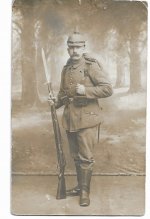Hi All,
I've been wanting to do a reference thread on these for a while. There isn't a tremendous amount of information on these accessories, so I thought I would at least share a basic primer on the various models. Recently, I was fortunate enough to be the new caretaker of an ultra-rare Emil Klinger cover (thanks again Mike!), so I figured the time was now. The production and historical context are outlined well within Storz's book. No pride of authorship here. Please add or correct if i missed or got something wrong.
Naturally the rough conditions of trench warfare were detrimental to weapons. Early attempts at an action cover were of cloth/canvas, though these were not particularly durable. In 1916, Emil Klinger presented a design for a metal cover which was rigid and covered the entirety of the action. The Klinger design was held into place with leather straps and had to be removed/stowed to use the rifle. This model was not well-received and was produced only in limited numbers. They are one of the most difficult accessories to find (in my experience). The finish appears to be a black paint.
Another design from Weissenburger & Co was presented and fared much better. This is the cover that most have encountered. The design is two piece and cycles with the bolt, providing much more convenient operation than the earlier Klinger design. This model was produced by Weissenburger, and a number of other firms under license.
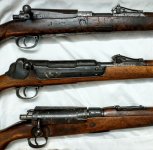
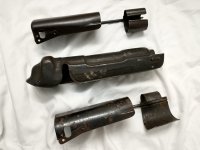




(Top to bottom: Gew 98 by Weissenburger, Gew 98 by Klinger, Kar98a by Bing)
The Gew 98 and Kar 98a models of the Weissenburger pattern are very similar with a couple of differences:
- The front of the Gew98 model fits over the barrel in between the receiver and rear sight; the Kar98a fits over the receiver ring and top of the trigger-guard/front action screw.
- The front piece is not symetrical on the Kar98a model; the bottom is significantly broader, while the top is small to fit over the receiver ring
With regard to markings- here are the markings on a Gew98 cover (both examples I own are Weissenburger)

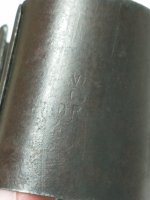
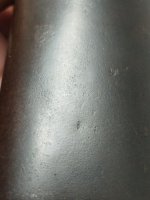
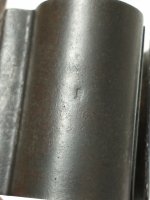
Weissenburger Trademarks on front and back + acceptance on each part.
Here are the markings on my Kar98a cover (This one is a Bing Bros/Nuremburg example):

Bing Trademark + Acceptance-- This example is only marked on the rear. The front section had some oxidation that may have obscured the markings.
It bears mentioning that reproductions do exist of the Gew98 Weissenburger model- a few notes:
- The most recent repros have a rust-colored front piece and latch for the bolt hole. They have a replicated Weissenburger trademark on parts, but no imperial acceptance. The finish is usually the best giveaway. The rear of the back portion of the cover is molded to the contours of the bolt shroud like originals.
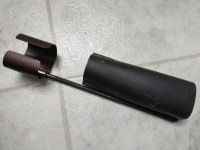


- The older repros are significantly tougher to identify at a distance. On most models, however, the rear of the back section has a simple round cut for the bolt shroud and is not contoured.
In any case, I hope some members find it helpful to have a picture reference. Thanks all and thanks again Mike for allowing me the honor of looking after this Klinger cover (the the sweet VCS 16 attached to it!)
I've been wanting to do a reference thread on these for a while. There isn't a tremendous amount of information on these accessories, so I thought I would at least share a basic primer on the various models. Recently, I was fortunate enough to be the new caretaker of an ultra-rare Emil Klinger cover (thanks again Mike!), so I figured the time was now. The production and historical context are outlined well within Storz's book. No pride of authorship here. Please add or correct if i missed or got something wrong.
Naturally the rough conditions of trench warfare were detrimental to weapons. Early attempts at an action cover were of cloth/canvas, though these were not particularly durable. In 1916, Emil Klinger presented a design for a metal cover which was rigid and covered the entirety of the action. The Klinger design was held into place with leather straps and had to be removed/stowed to use the rifle. This model was not well-received and was produced only in limited numbers. They are one of the most difficult accessories to find (in my experience). The finish appears to be a black paint.
Another design from Weissenburger & Co was presented and fared much better. This is the cover that most have encountered. The design is two piece and cycles with the bolt, providing much more convenient operation than the earlier Klinger design. This model was produced by Weissenburger, and a number of other firms under license.






(Top to bottom: Gew 98 by Weissenburger, Gew 98 by Klinger, Kar98a by Bing)
The Gew 98 and Kar 98a models of the Weissenburger pattern are very similar with a couple of differences:
- The front of the Gew98 model fits over the barrel in between the receiver and rear sight; the Kar98a fits over the receiver ring and top of the trigger-guard/front action screw.
- The front piece is not symetrical on the Kar98a model; the bottom is significantly broader, while the top is small to fit over the receiver ring
With regard to markings- here are the markings on a Gew98 cover (both examples I own are Weissenburger)




Weissenburger Trademarks on front and back + acceptance on each part.
Here are the markings on my Kar98a cover (This one is a Bing Bros/Nuremburg example):

Bing Trademark + Acceptance-- This example is only marked on the rear. The front section had some oxidation that may have obscured the markings.
It bears mentioning that reproductions do exist of the Gew98 Weissenburger model- a few notes:
- The most recent repros have a rust-colored front piece and latch for the bolt hole. They have a replicated Weissenburger trademark on parts, but no imperial acceptance. The finish is usually the best giveaway. The rear of the back portion of the cover is molded to the contours of the bolt shroud like originals.



- The older repros are significantly tougher to identify at a distance. On most models, however, the rear of the back section has a simple round cut for the bolt shroud and is not contoured.
In any case, I hope some members find it helpful to have a picture reference. Thanks all and thanks again Mike for allowing me the honor of looking after this Klinger cover (the the sweet VCS 16 attached to it!)
Last edited:





